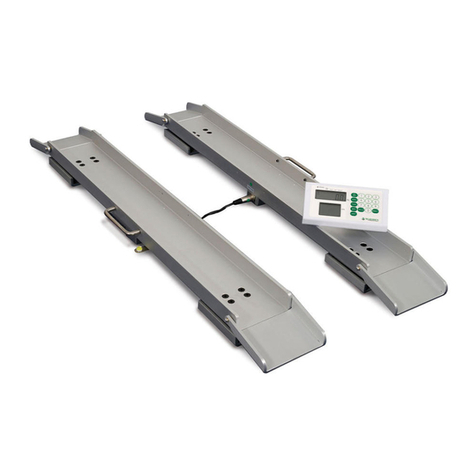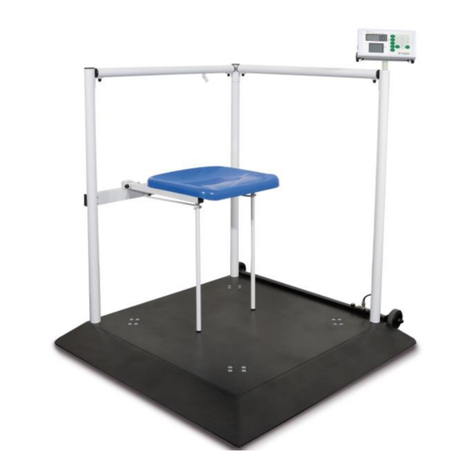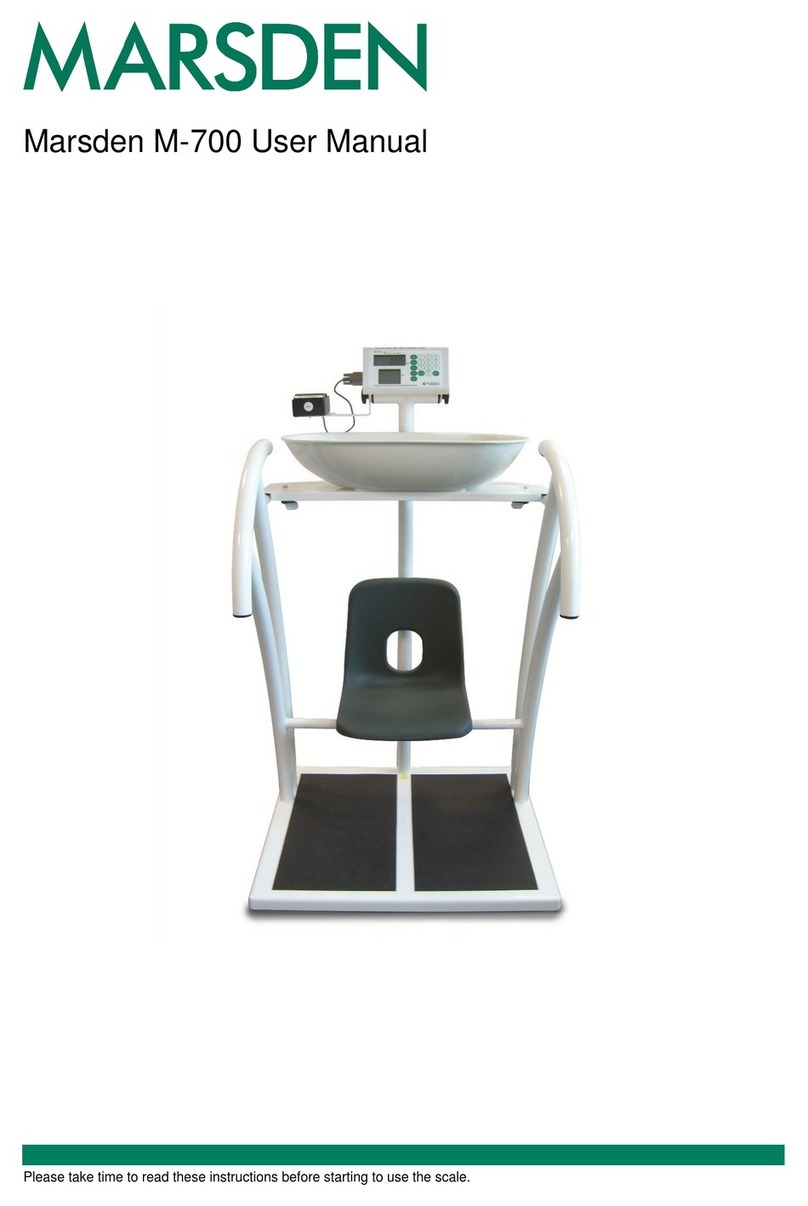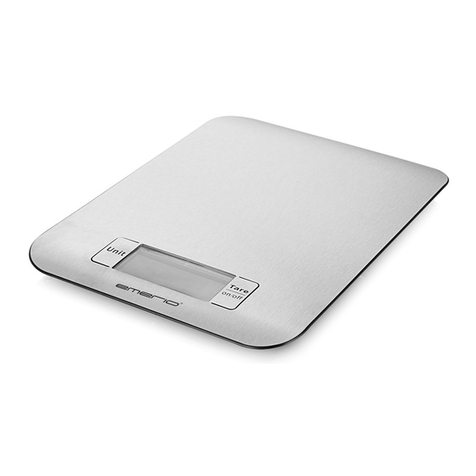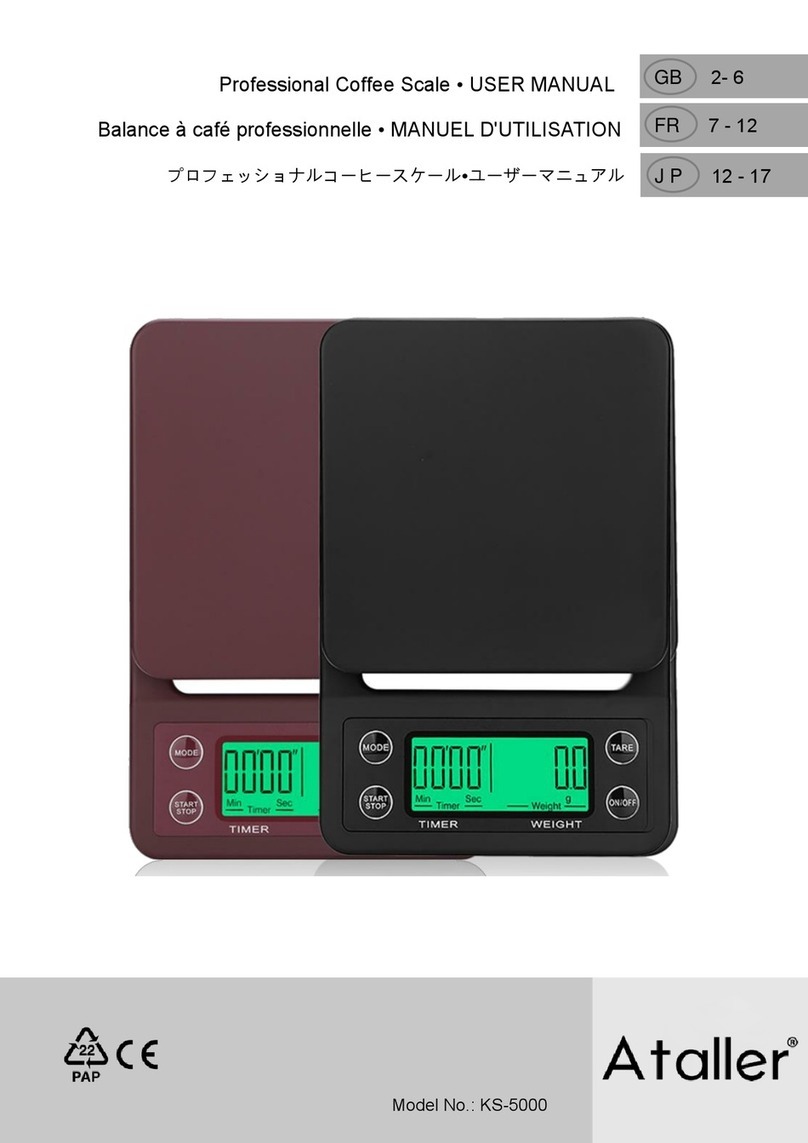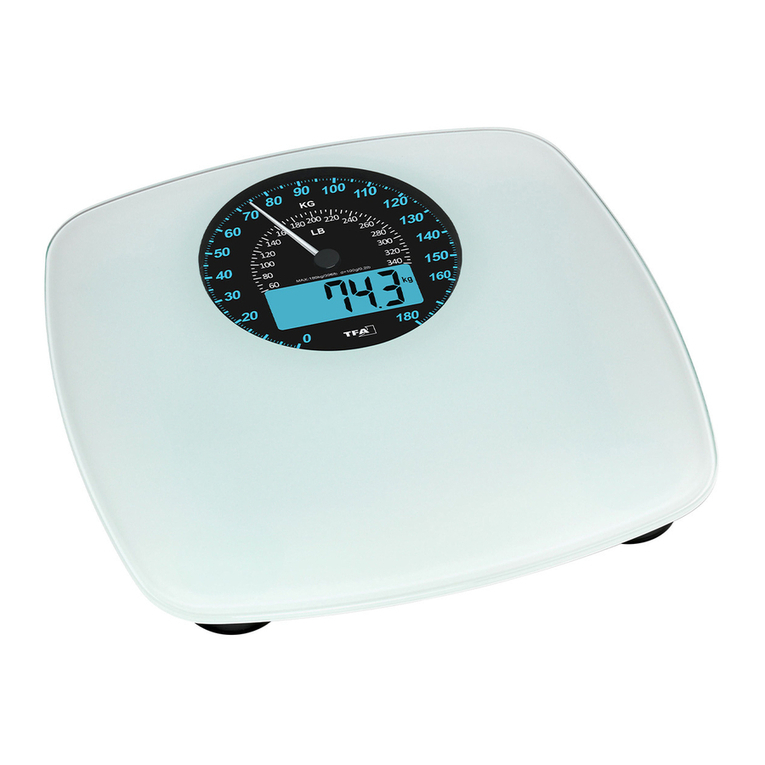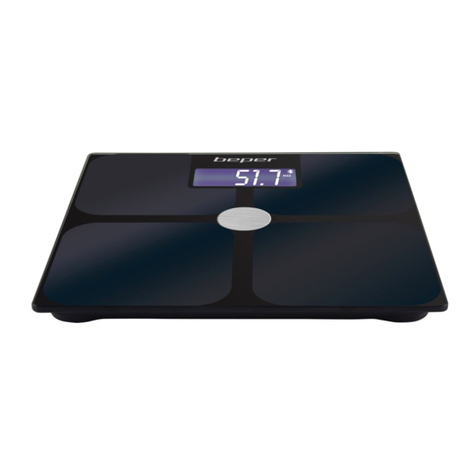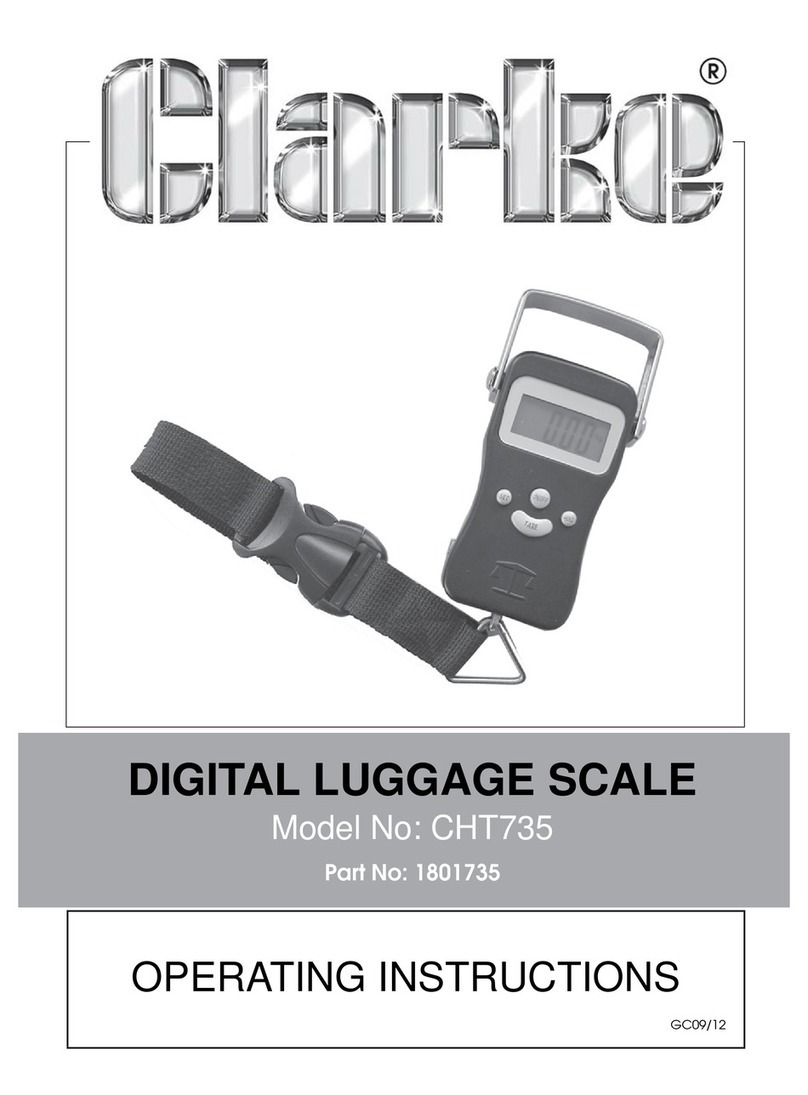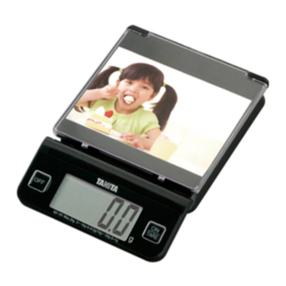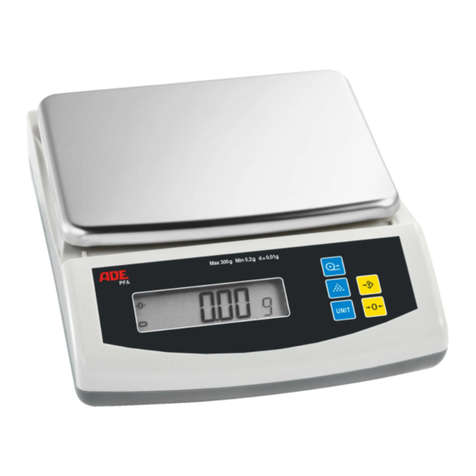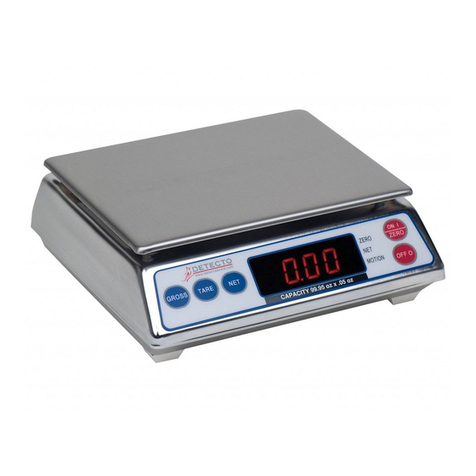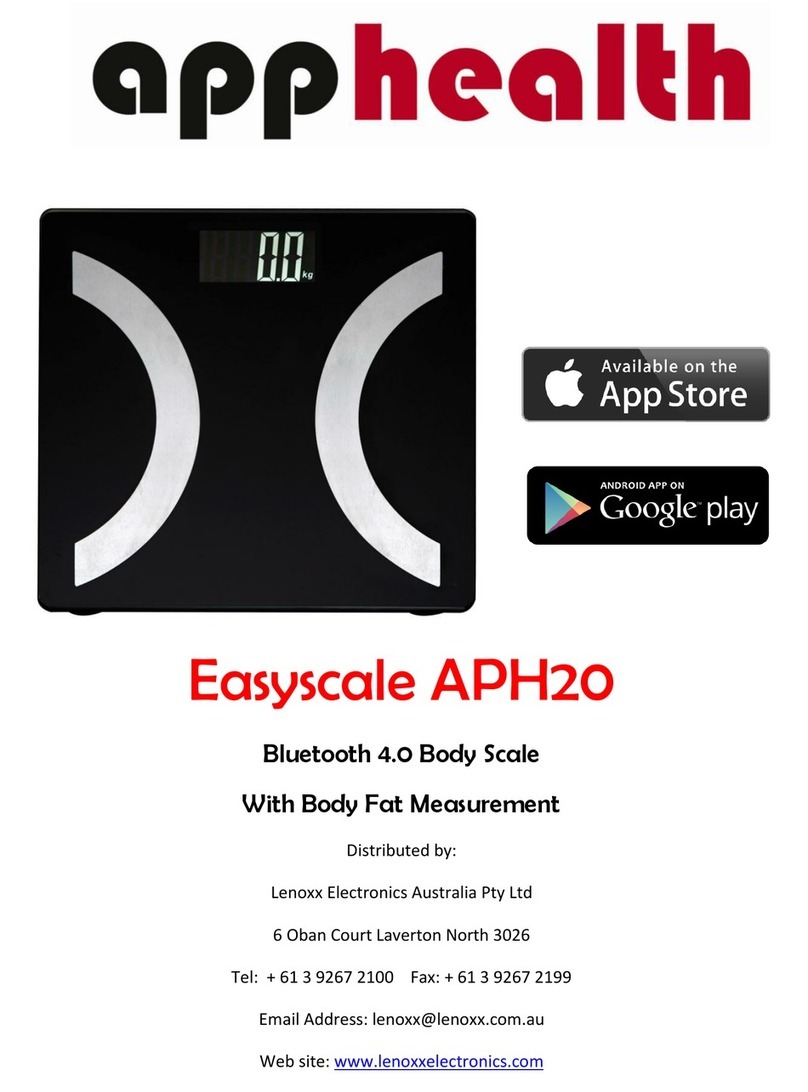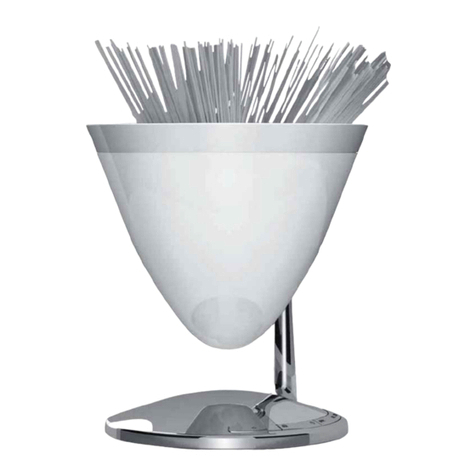marsden M-110 User manual

USER MANUAL
M-110
Please take time to read these
instructions before starting
to use the scale
Version 1.2 09/19
Please keep this instruction manual to hand for future reference

Contents
Introduction 3
Product Specification 3
SafetyInstructions 4
Explanation of Graphic Symbols 5
Power Supply and Low Battery 6
BeforeUse 7
Operation: Basic Functions 8
Operation: Advanced Functions 10
Using the Scale with a Printer 14
Using the Scale with Bluetooth 15
Attaching the Height Measure 16
EMC Guidance and Manufacturer’s Declaration 17
Recommended Separation Distance 20
ErrorMessages 21
Manufacturer’s Declaration of Conformity 23
Page 2

Thank you for purchasing a Marsden professional medical scale. This is a precision
Class III Weighing Instrument and considerate use will result in many years of
accurate weighing.
The scale has a maximum load capacity of 250kg which must not be exceeded.
Product Specification
Model M-110
Accuracy Class Class III
Capacity/Division 250kg x 100g
Weight of Scale Approximately 9kg
Units of Measure Kg
Function Keys ON/OFF, HOLD, TARE, BMI, UNIT, 0-9
Stabilization Time 1-2 Seconds
Operating Temperature 0 to 40˚C
Power Supply
Rechargeable battery pack
6 x AA batteries*
12V 1A AC Adaptor
Indicator Display 2.5cm LCD display with 5 active digits
*contact Marsden for details
If the device is under legal metrology control(self-verification)
Marsden will provide notified body no. 0122 on the device
Page 3

Safety Instructions
Before putting the device into use, please read with care the information given in this user manual, which
contains important instructions for proper installation, use and maintenance of the device.
Marsden/the manufacturer shall not be liable for damages arising from failure to heed the following
instructions:
When using electrical components under increased safety requirements, always comply with
appropriate regulations.
Inappropriate installation/use will render the warranty null and void.
Ensure the voltage marked on the power supply unit matches your mains supply.
This device is designed for use indoors.
Observe the permissible ambient temperatures for use.
The device meets the requirements for electromagnetic capability. Do not exceed the maximum
values specified in the applicable standards.
Batteries should be kept away from small children. If swallowed, promptly seek medical assistance.
If you have any problems, contact Marsden/your local dealer/your service partner.
Cleaning
We recommend using alcohol-based wipes or similar when cleaning the scale.
Please do not use corrosive liquids, large amounts of water or high-pressure washers.
Always disconnect the scale from the mains power supply before cleaning.
Maintenance
The scale does not require any routine maintenance. However, we recommend checking the
scale’s accuracy at regular intervals. If any inaccuracies occur, please contact your local dealer or
service partner.
Disposing of the Scale
This product should not be treated as regular household waste, but should be handed in
to an electrical/electronic equipment recycling center.
You can obtain further details from your local council, your municipal waste disposal
company or from where you purchased the product.
Intended use
This scale is intended for use to determine the weight of patients, supported by
professional personnel and in rooms intended for carrying out healthcare. The weighing
value can be read after a stable weighing value has been obtained. Before use, the scale
must be checked by an authorised person to ensure it's in a suitable condition.
Page 4

Explanation of Graphic Symbols
SN-21300100
Designation of the serial number of every
device.
(Number as an example)
“Please note the accompanying
documents” or “Observe operating
instructions”
Charder Electronic Co. Ltd
No.103 Guozhong Rd, Dali Dist,
Taichung City 412, Taiwan (R.O.C)
Identification of manufacturer of medical
product including address.
“Electro-medical appliance” with
attachment of type B.
Dispose of old appliances separately from
your household waste.
This product must be disposed of at a
communal collection point.
Carefully read this operation manual
before setup and commissioning, even if
you are already familiar with Marsden
scales.
Page 5

Power Supply & Low Battery
The indicator uses a rechargeable battery pack or can be powered from the mains via the AC
adaptor.
Make sure the battery pack is installed in the battery box of the indicator. Alternatively, plug the
AC adaptor (12V 2A) into the port on the side of the indicator.
Installing & Replacing the Battery Pack
1. Take out the battery housing.
2. The rechargeable battery pack will slide into, or out of, the housing.
3. Check that the housing pin is connecting to the right point inside the indicator.
4. Place the housing back in the back of the indicator, and close the battery housing cover.
Optional battery
holder (to fit AA sized
batteries – contact
your dealer)
Page 6

Before Use
1) Place the scale on a firm and level surface
2) Unwind the levelling feet until they make contact with the ground.
3) Ensure that all four of the levelling feet and the wheels are firmly on the
ground and that the spirit level bubble is located in the center as shown
below:
Correct: Incorrect:
Page 7

Operation: Basic Functions
Switching on the Scale
Press the ON/OFF button firmly.
The scale will first test all of the display
segments.
The scale will now show its current
software version number.
The scale will now go into weighing
mode and should show 0.0kg on the
display.
Page 8

Switching off the Scale
Press the ON/OFF button when the scale
is turned on. The scale will now power
down.
Setting the Scale to Zero
If for any reason the scale shows a
reading other than 0.0kg it can be reset
to zero.
Press the ZERO key once.
The scale will return to 0.0kg.
Page 9

Operation: Advanced Functions
Hold Function
Press the HOLD button once.
Allow the patient to stand on the scale.
After a few seconds the scale will lock
on the person’s weight. When the
patient leaves the scale, the weight will
remain on the display.
Press HOLD again to disable the Hold
function and return the scale to 0.0kg.
Page 10

Body Mass Index (BMI) Function
In normal mode, press the BMI button to
enter into BMI mode.
The display will show the last height
entered and the extreme left digit will
flash. Enter the height by using the
numeric keys.* Press ZERO to confirm the
height. (NB: There will always be an active
flashing digit in the height display, unless
HOLD is pressed).
Weigh the patient as normal. The display
will show the weight, height and BMI
value. At this time, the weight and height
can be freely changed, and the BMI value
will be automatically calculated according
to the changed weight and height.
Press BMI to return to normal weighing
mode.
*If the scale is fitted with an automatic
height measure, the display will show the
height accordingly when the cursor is
raised or lowered.
Page 11

Tare and Preset Tare Functions
Press TARE for three seconds to enter
Preset Tare setting mode. When the cursor
points to Pre Tare on the display press
TARE once more. The display will show the
last preset tare value entered.
The left digit on the display will flash. Enter
the preset tare value by using the numeric
keys, then press TARE again to confirm the
value.
The display will now show the figure you
entered deducted from 0.0kg. The scale is
now ready to use.
To use the Tare function, add the item you
wish to tare off to the scale, and press
TARE. The display will show zero, and then
a minus number when the item is removed
from the scale.
Page 12

Setting the Date
Press HOLD for three seconds to access the time setting mode. The time period digit
that is flashing can be changed by entering the appropriate number from the numeric
key pad. The time period to be edited is selected by pressing HOLD.
E.g. To input 25 December 2008, 8:00 a.m.:
Enter the year. Press HOLD to confirm
and access the date editing field.
Enter the date. E.g. “12.25” for
December 25th. Press HOLD to confirm
and access the time clock editing field.
Enter the time (24 hour clock only).
Press HOLD and the display shows:
YYYY→MM.DD→HH:SS
Press HOLD to return to normal
weighing mode.
Page 13

Using the Scale with a Printer
An optional Marsden external thermal printer (model TP-2100) is available for all models.
When the printer is fitted, the patient’s weight, height, and BMI result can be printed.
Once the person has been weighed and their BMI calculated, simply press PRINT to produce
the following ticket:
Connecting the TP-2100 Thermal Printer
Plug the cable to the printer, and then connect its 9D connector to the indicator.
GROSSWEIGHT 60.00kg
TARE WEIGHT 30.00kg
NETWEIGHT 30.00kg
PATIENT HEIGHT 100.0cm
PATIENTB.M.I 37.5
29/12/2008 17:00
Page 14

Using the Scale with Bluetooth
If your scale has Bluetooth connectivity, the universal Bluetooth symbol will be on the
main indicator display.
Bluetooth Connection
Long press ZERO for three seconds to enter the Setting mode
and then display the A-OFF menu.
Press TARE twice, and then press HOLD once to enter the
Bluetooth setting mode.
Using HOLD, select “ON” (enable) or “OFF” (disable).
Press TARE to confirm the setting.
Note: Disabling the Bluetooth function when not in use will
reduce battery power consumption.
Display the “bluEt” menu. Press TARE once.
Press HOLD to return to normal mode.
Search for the scale in your computer or device’s Bluetooth
settings (procedure may vary depending on device or system)
The scale will appear on the Bluetooth device list as
“MARSDEN BT”.
Connect your device to “MARSDEN BT”, and the scale is ready
to transmit data wirelessly via Bluetooth.
Page 15

Attaching the Height Measure
The M-110 can be purchased with a height measure. If you did not purchase your M-110
with a height measure, it is also available separately (model HM-201M).
Using the four M5*0.8*9 screws provided,
mount the two brackets onto the column of
the M-110.
Using the four M5*0.8*25 screws provided,
screw the black blocks onto the mounting
brackets.
Using the two M6*1.0*10 screws provided,
screw the HM-201M to the black blocks.
To measure a person’s height, retract the
height rod and position the head stop
accordingly.
For M-110 spare parts, call Marsden on 01709 364296.
Page 16

EMC Guidance and Manufacturer’s Declaration
Guidance and manufacturer’s declaration-electromagnetic emissions
The MEDICAL SCALE M-110 is intended for use in the electromagnetic environment specified
below.
The customer or the user of the MEDICAL SCALE M-110 should assure that it is used in such an
environment.
Emission test Compliance Electromagnetic environment-guidance
RF emissions CISPR 11 Group 1 The MEDICAL SCALE M-110 uses RF
energy only for its internal function.
Therefore, its RF emissions are very low
and are not likely to cause any
interference in nearby electronic
equipment.
RF emissions CISPR 11
Class B The MEDICAL SCALE M-110 is suitable
for use in all establishments, including
domestic establishments and those
directly connected to the public low-
voltage power supply network that
supplies buildings used for domestic
purposes.
Harmonic emissions IEC 61000-
3-2
Class A
Voltage fluctuations /flicker
emissions IEC 61000-3-3
Compliance
Guidance and manufacturer’s declaration-electromagnetic immunity
The MEDICAL SCALE M-110 is intended for use in the electromagnetic environment specified
below.
The customer or the user of the MEDICAL SCALE M-110 should assure that it is used in such an
environment.
Immunity test IEC 60601 test level Compliance level Electromagnetic environment-
guidance
Electrostatic
discharge(ESD)
IEC 61000-4-2
± 8 kV contact
± 2 kV, ± 4 kV, ± 8
kV, ± 15 kV air
± 6 kV contact
± 8 kV air
Floors should be wood,
concrete or ceramic tile. If
floors are covered with
synthetic material, the relative
humidity should be at least
30%
Electrical fast
transient/burst IEC
61000-4-4
± 2kV for power
supply lines + 1kV
for input/output
lines
± 2kV for power
supply lines Not
applicable
Mains power quality should
be that of a typical
commercial or hospital
environment.
Surge IEC 61000-4-
5
± 1kV line(s) to
line(s) ± 2kV line(s)
to earth
± 1kV differential
mode Not applicable
Mains power quality should
be that of a typical
commercial or hospital
environment.
Page 17

Voltage Dips, short
interruptions and
voltage variations
on power supply
input lines IEC
61000-4-11
0% UT for 0,5 cycle
0% UT for 1 cycle
70% UT(30% dip in
UT) for 25 cycles
0% UT for 5 s
<5% UT(>95% dip in
UT) for 0,5 cycle 40%
UT(60% dip in UT)
for 5 cycles 70%
UT(30% dip in UT)
for 25 cycles <5%
UT(>95% dip in UT)
for 5 s
Mains power quality should
be that of a typical
commercial or hospital
environment. If the user of
the MEDICAL SCALE M-110
requires continued operation
during power mains
interruptions, it is
recommended that the
MEDICAL SCALE M-110 be
powered from an
uninterruptible power supply
or a battery.
Power
frequency(50/60
Hz) magnetic field
IEC 61000-4-8
30 A/m
3 A/m The MEDICAL SCALE M-110
power frequency magnetic
fields should be at levels
characteristic of a typical
location in a typical
commercial or hospital
environment.
NOTE UT is the a.c. mains voltage prior to application of the test level.
Guidance and manufacturer’s declaration-electromagnetic immunity
The MEDICAL SCALE M-110 is intended for use in the electromagnetic environment specified
below.
The customer or the user of the MEDICAL SCALE M-110 should assure that is used in such and
environment.
Immunity test IEC 60601 test level Compliance
level
Electromagnetic environment-
guidance
Conducted RF
IEC 61000-4-6
3 Vrms
150 KHz to 80 MHz
6 V in ISM bands
between 0,15 MHz and
80 MHz
80 % AM at 1 kHz
3 Vrms
Portable and mobile RF
communications equipment
should be used no closer to any
part of the MEDICAL SCALE M-
110 including cables, than the
recommended separation
distance calculated from the
equation applicable to the
frequency of the transmitter.
Recommended separation
distance:
d = 1,2 √
P
d = 1,2 √
P
80MHz to 800 MHz
d = 2,3 √
P
800MHz to 2,7 GHz
Where
P
is the maximum output
power rating of the transmitter
in watts (W) according to the
transmitter manufacturer and
d
is the recommended separation
Page 18

Radiated RF IEC
61000-4-3
3 V/m 80MHz to 2,7
GHz
3 V/m
distance in metres (m).
Field strengths from fixed RF
transmitters, as determined by
an electromagnetic site surveya,
should be less than the
compliance level in each
frequency rangeb.
Interference may occur in the
vicinity of equipment marked
with the following symbol:
NOTE1 At 80 MHz and 800 MHz, the higher frequency range applies.
NOTE2 These guidelines may not apply in all situations. Electromagnetic propagation is affected
by absorption and reflection from structures, objects and people.
a Field strengths from
f
ixed transmitters, such as base stations for radio (cellular/cordless)
telephones and land mobile radios, amateur radio, AM and FM radio broadcast and TV
broadcast cannot be predicted theoretically with accuracy. To assess the electromagnetic
environment due to fixed RF transmitters, an electromagnetic site survey should be considered.
If the measured field strength in the location in which the MEDICAL SCALE M-110 is used
exceeds the applicable RF compliance level above, the MEDICAL SCALE M-110 should be
observed to verify normal operation. If abnormal performance is observed, additional measures
my be necessary, such as re-orienting or relocating the MEDICAL SCALE M-110.
b Over the frequency range 150 kHz to 80 MHz, field strengths should be les than 3 V/m.
Page 19

Recommended separation distance between portable and mobile RF communications equipment
and the MEDICAL SCALE
The MEDICAL SCALE M-110 is intended for use in an electromagnetic environment in which
radiated RF disturbances are controlled. The customer or the user of the MEDICAL SCALE M-110
can help prevent electromagnetic interference by maintaining a minimum distance between
portable and mobile RF communications equipment (transmitters) and the MEDICAL SCALE M-110
as recommended below, according to the maximum output power of the communications
equipment.
Rated maximum output
power of transmitter
W
Separation distance according to frequency of transmitter m
150 kHz to 80 MHz
d =1,2√
P
80 MHz to 800 MHz
d =1,2√
P
800 MHz to 2,7 GHz
d =2,3√
P
0,01 0,12 0,12 0,23
0,1 0,38 0,38 0,73
1 1,2 1,2 2,3
10 3,8 3,8 7,3
100 12 12 23
For transmitters rated at a maximum output power not listed above, the recommended separation
distance d in metres (m) can be estimated using the equation applicable to the frequency of the
transmitter, where p is the maximum output power rating of the transmitter in watts (W) according
to the transmitter manufacturer.
NOTE1 At 80 MHz and 800 MHz, the separation distance for the higher frequency range applies.
NOTE2 These guidelines may not apply in all situations. Electromagnetic propagation is affected by
absorption and reflection from structures, objects and people.
Page 20
Table of contents
Other marsden Scale manuals
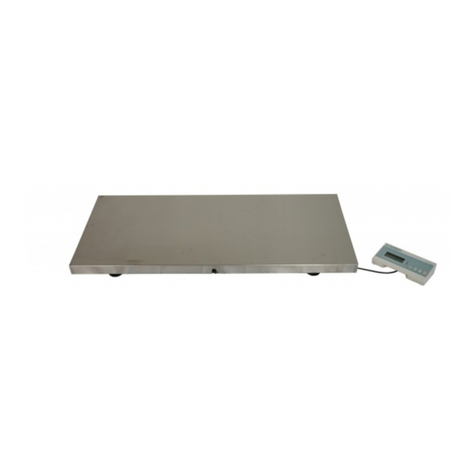
marsden
marsden VS 250E User manual
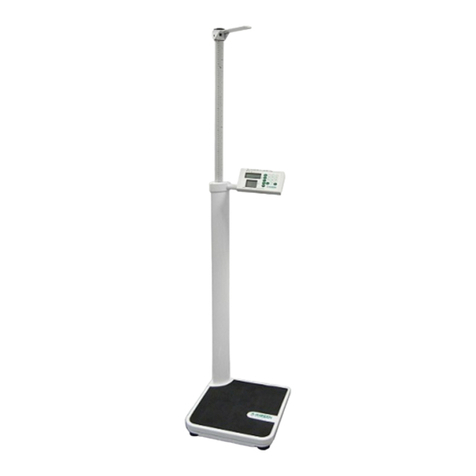
marsden
marsden M-100 User manual

marsden
marsden B-450 User manual

marsden
marsden M300 User manual
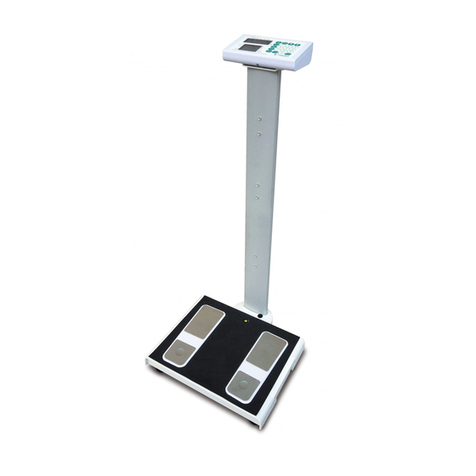
marsden
marsden MBF-6010 User manual
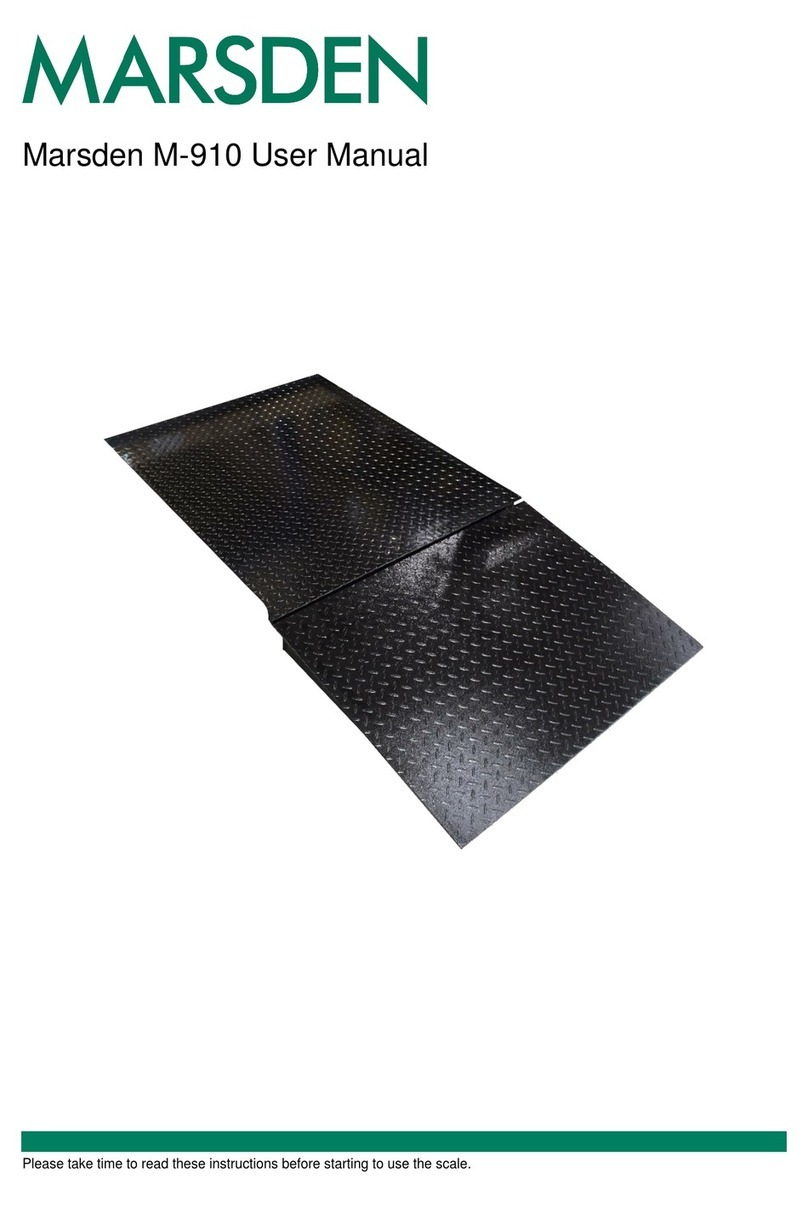
marsden
marsden M-910 User manual
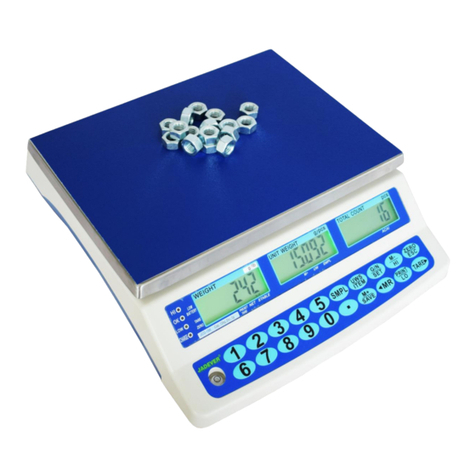
marsden
marsden Jadever JCO User manual

marsden
marsden VT-250 User manual
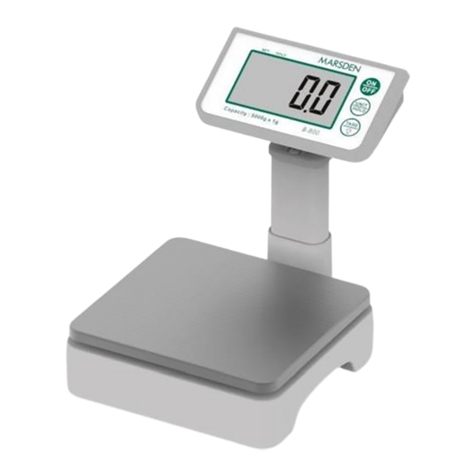
marsden
marsden B-800 User manual
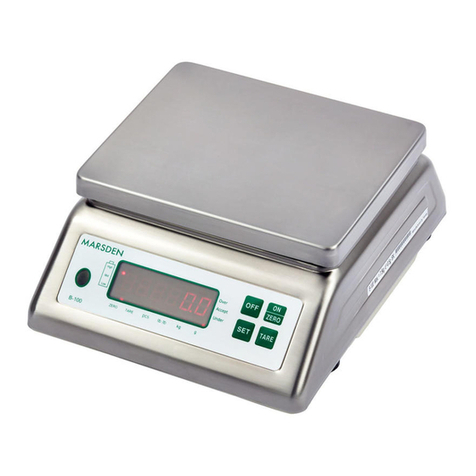
marsden
marsden B-100 User manual
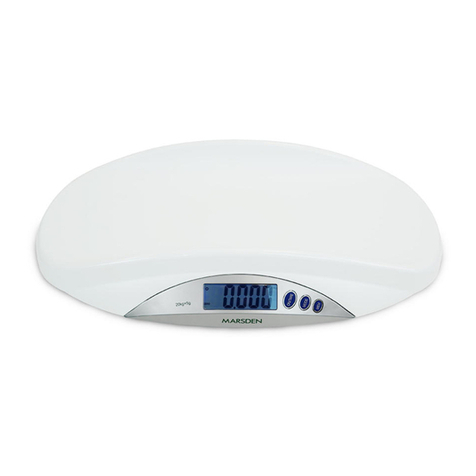
marsden
marsden V-22 User manual
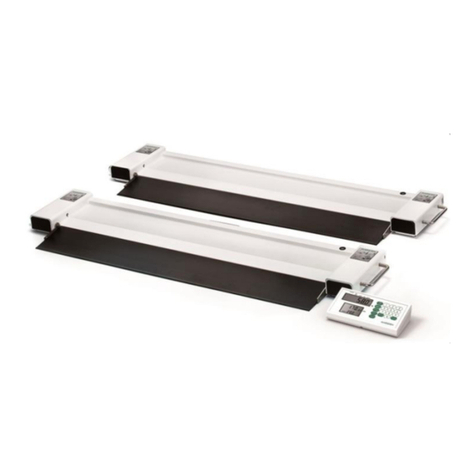
marsden
marsden M-900 User manual
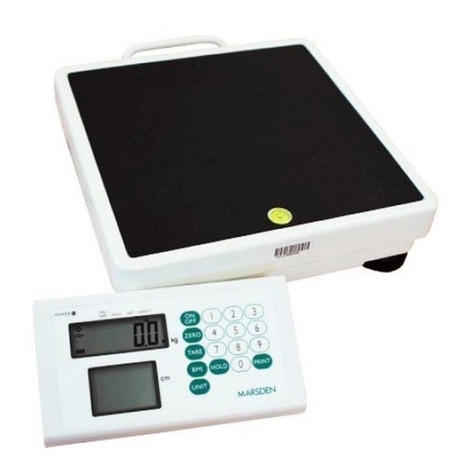
marsden
marsden M-510 User manual
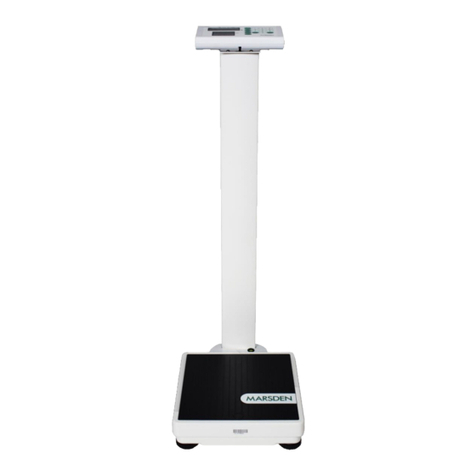
marsden
marsden M-160 User manual
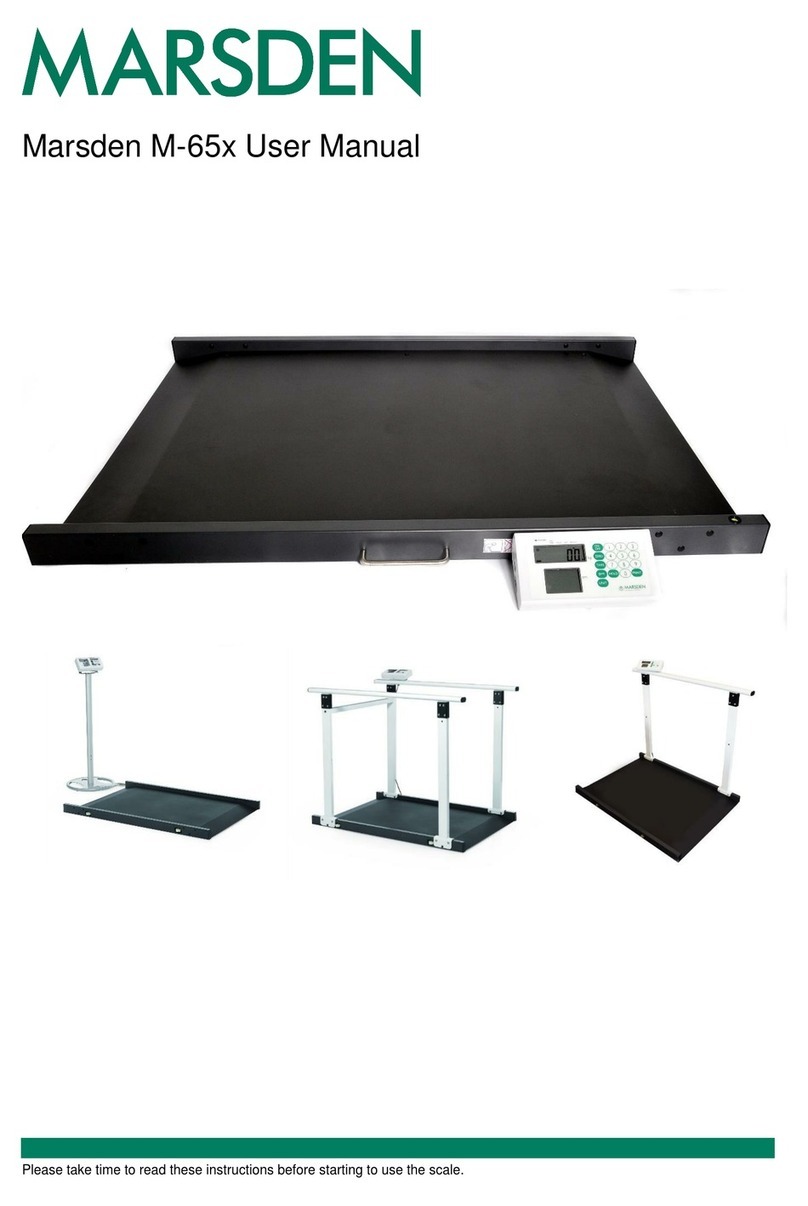
marsden
marsden M-65 Series User manual
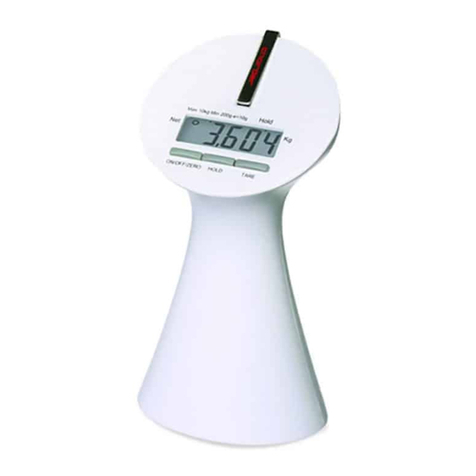
marsden
marsden MS-4400 User manual
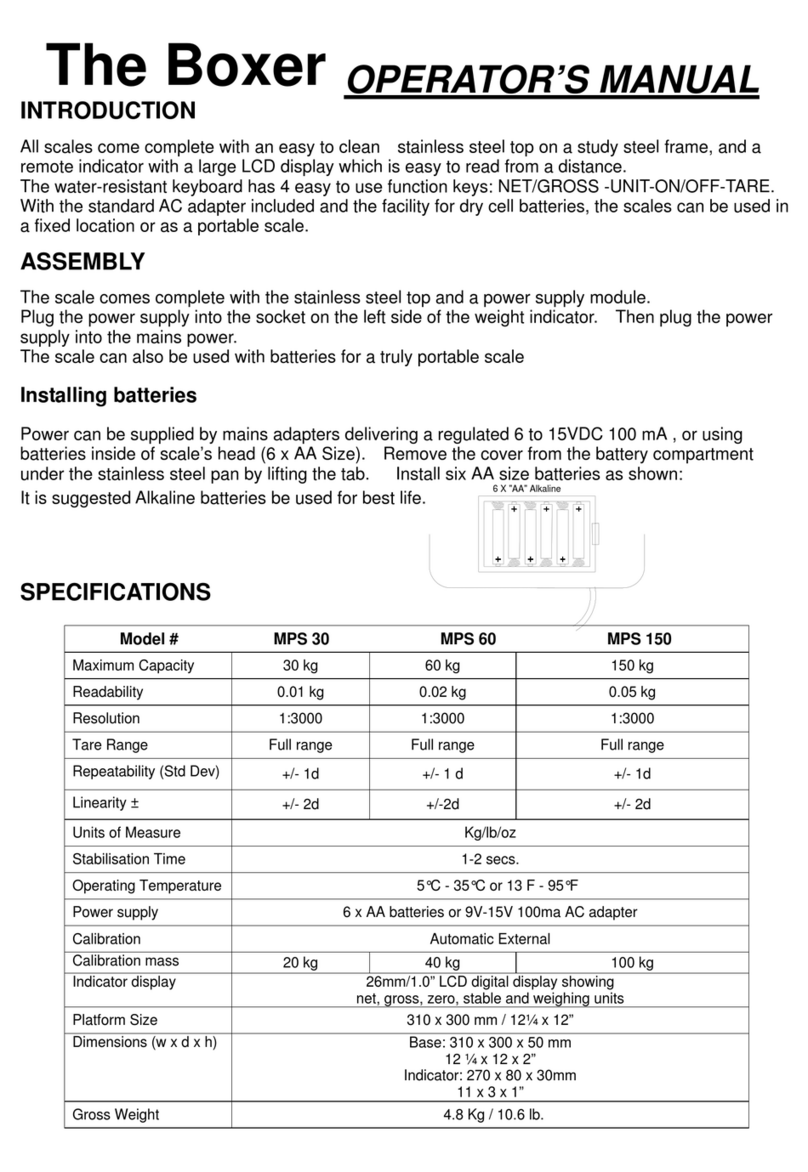
marsden
marsden Boxer MPS 30 User manual
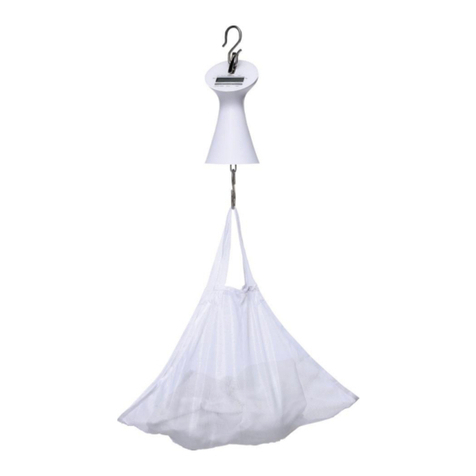
marsden
marsden M-310 User manual
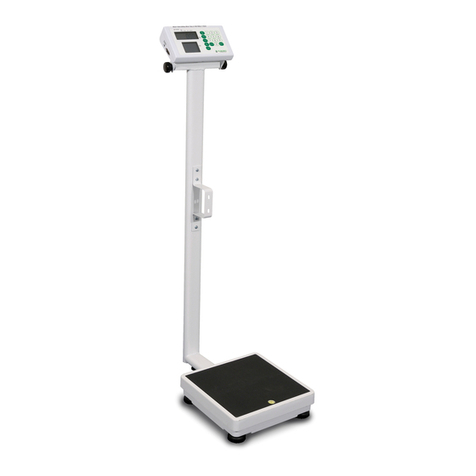
marsden
marsden MPPS-250 User manual

marsden
marsden V-24 User manual
